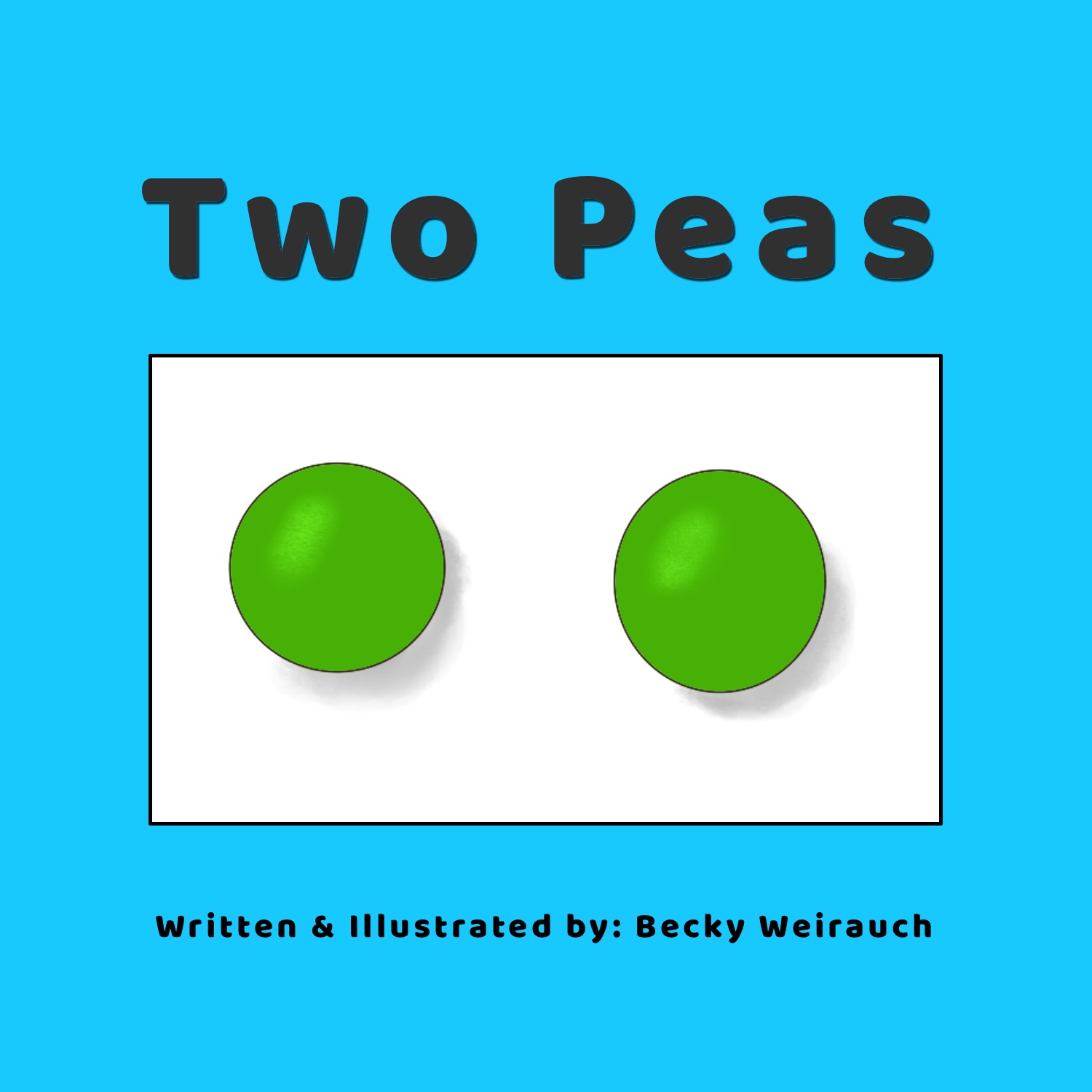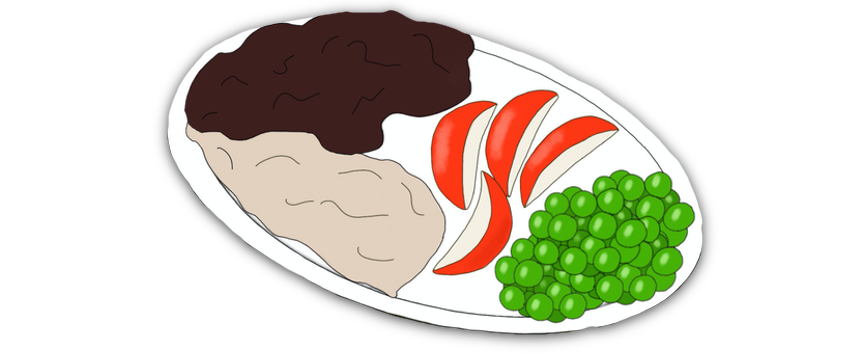
What’s It All About?
For some reason the first line of the book popped into my head one day. I wasn’t even eating peas. My brain can be a random place. From there it became a story that has more lessons for parents than for children.
Considering the issues that so many of us have with controlling our eating habits, it’s hard to think that so many children start out with an aversion to eating. I’ve worked with kids that refused to eat more than one bite of their dinner, even after a strenuous day of playing. I’ve even seen kids who refused dessert! I was never that kid. I was more of the kid who had to be convinced not to eat so much.
It can be very stressful when a growing child you know should be hungry claims they aren’t hungry. Your mind starts to obsess about whether or not they are getting the proper nutrition. Are they sick? Are they just being stubborn? Should you punish them? Should you let them eat what they will, even if it is just a scoop of peanut butter?
Two Peas is a book that encourages parents to meet their child where they are at. Blue’s mom could have taken a different approach. She could have forced Blue to eat a whole cup of peas as a punishment for her defiance. She could have told Blue she couldn’t leave the table until every last pea was gone. Blue may have screamed and cried or sat all night at the table with her arms crossed. Kids will often go to extremes to show their disapproval. Her mom would have asserted her dominance, but she also may have temporarily strained her relationship with Blue. Worse yet, she may have permanently changed Blue’s mind about peas. Blue may now connect the healthy food to a bad experience, and may like them less.
It’s easy to fall into the trap of saying, “because I said so.” Blue’s mom starts dinner by trying to bargain with Blue. You see the start of what happens in so many people’s dinner time. Blue makes a demand, Blue’s mom counters, Blue starts to shut down. The tension hits a pinnacle where we see Blue with her arms crossed. Her mom sees that and instead of moving into dominant parent mode, she moves into Blue’s world. She makes dinner fun! Imagine the conversations the mother and daughter could have had as they talked about their food villages. It may have been a little tricky when they realized they had to eat the poor people of the town, but we won’t think about that one too much.

Lessons for Children
It’s important for children to be able to express themselves. If a child doesn’t want to eat something, you can encourage them to tell you why. Maybe a kid at school made fun of them for liking beans, the magical fruit. They make you toot, you know. Maybe they are currently existing in their own magical world where they don’t eat foods that are orange. Maybe they are not wanting to eat because their stomach hurts, a more serious thing to consider. Maybe they don’t want to eat because you have unintentionally created a power struggle by forcing them to eat those Brussels Sprouts yesterday. Encourage children to communicate, so you can understand what’s going on.

Lessons for Adults
I’ve met adults who have hated foods such as broccoli or carrots. When asking them why they despised the vegetable, they would often say that a parent used to force them to eat it. If you asked them the last time they tried it, they hadn’t even touched the stuff since they were a kid. That bad experience they had with being forced to eat something they didn’t want, had defined their actions for a lifetime. This is important to keep in mind. The very thing you may want to encourage your kid to do could be the very thing you are encouraging them not to do.
Sometimes kids really don’t want to eat something. It is natural for children to go through phases with food. Their taste buds are different from adult taste buds, so they may pick up on different aspects of a food that you don’t. There’s a reason kids don’t crave that bitter taste of coffee. It is important to keep the fact that you may not want to eat something, even if you like it. Believe me, I have had several vegetables go bad in my fridge, just because the idea of peeling them was too much of a burden for me.
Children are learning and growing in this confusing world. Sometimes their emotions come out in ways that we don’t understand as adults. Sometimes a bad play date is taken out on tonight’s pot roast. Pay attention to trends. A child who doesn’t want to eat a lot tonight, may just be a child having a bad day. A child who doesn’t want to eat for a few days in a row, may be a child going through something deeper that you may want to look into further.

Ideas for a Better Dinner!
Dinner time is a common cause of stress for several families with kids. Sometimes they just don’t want to eat what you want them to eat. There are some good ways to help make dinner a more enjoyable process. These may not all work, you can try them and see what works.
Let Them Help Shop!
Instead of just picking out healthy foods and expecting a child to eat them, you can try to involve them in the process. Let them pick the apples you buy, gently encouraging them to avoid that rotten one. Let them help you pick colorful foods and arrange them in the cart or basket. Name the produce you pick out and let your child tell you about their life story.
You can also let them pick foods you haven’t tried yet, like a crazy looking jackfruit, or dragon fruit. If you haven’t seen a dragon fruit, it will most likely shock a child when you finally cut it open and look inside. Do always keep in mind the potential for finding new food allergies when trying new foods, and do so with caution. Also keep in mind that you should not do this if you want to get your shopping done quickly. You may be stuck in the aisle for 15 minutes as your child asks you what every single item is.
Let Them Help Cook!
Much like grocery shopping with a child, cooking with a child must also be done when the adult is in the right mindset. Mistakes will probably be made. I suggest getting into it fully! Pretend you own a restaurant and are cooking for your guests. Avoid having the child stand there and dump the contents of a can in a pot and expect them to stand there and watch. This most likely won’t end well for either of you. Let them get involved. Just make sure you keep them safe in the process. Be mindful of sharp utensils and raw meats.
Imagine with Them!
So many of us have strict expectations for what dinner entails. Many want dinner to be a time for eating, table manners, and light conversation. If that’s your thing, you do you! I personally think that one of the most important things we can do for children is to help them strengthen your imagination. If you are up for letting go of the restrictions of being an adult, you can move into your child’s world for a half an hour or so. Work with your child to decide where you are eating tonight. Are you dragons eating in your lair? Is that pile of corn actually pieces of gold that you have to eat to store for safekeeping in your belly? You can even get a child to be excited about doing dishes with you if you present it in the right way! Maybe you can imagine that those dirty plates have special messages on them. You have to clean them off to read the messages.
Prepare Food Different Ways!
One fun activity you can try to assess a child’s preferences is to pretend you are in a cooking competition and the children are the judges. You can give them small samples of a food and let them rate each one. For example, you could give a child a small sample of cheesy broccoli, a piece of raw broccoli with some ranch, and steamed broccoli with balsamic vinegar and olive oil. Let them rate each one. Sometimes children will surprise you. I once met a kid who swore their favorite food was raw broccoli. Another who loved bananas above all else.
Pretend It Is a Restaurant!
You can make a fun night by turning your dining room into a restaurant. Make a menu with a few types of foods. Let them choose their food and drinks from the menu, and serve the food to them like it is a restaurant. You can even give them fake money to pay with at the end of the meal.
Secret Food!
Did you know you can add food to a child’s diet without them knowing it? Again, always keep in mind food allergies when trying this, especially if you are feeding other people’s children.
I kid you not, you can add white beans to baked goods such as cookies for up to half of the butter? You can add mashed cauliflower to your mashed potatoes or grate vegetables and add them to tomato sauce. Ideally you want a child to know what they are eating, so they can start creating those positive experiences with different foods. However, if you need a way to get a picky child to eat their veggies, this can help you ease them into foods to which they may have aversions.
In Conclusion
Meals can be a great time to connect with each other, they can also be a time of great stress. Consider the ways you interact with children and food. Are your actions affecting the things your child will and won’t eat? Are you helping them to enjoy trying new things?